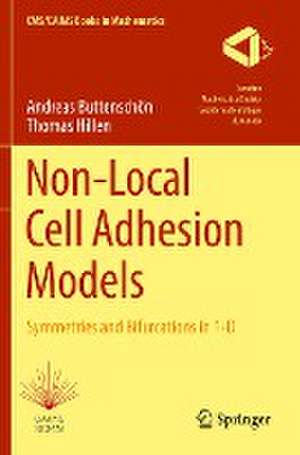Non-Local Cell Adhesion Models: Symmetries and Bifurcations in 1-D: CMS/CAIMS Books in Mathematics, cartea 1
Autor Andreas Buttenschön, Thomas Hillenen Limba Engleză Paperback – 11 iun 2022
| Toate formatele și edițiile | Preț | Express |
|---|---|---|
| Paperback (1) | 489.20 lei 3-5 săpt. | +12.96 lei 6-12 zile |
| Springer International Publishing – 11 iun 2022 | 489.20 lei 3-5 săpt. | +12.96 lei 6-12 zile |
| Hardback (1) | 726.23 lei 6-8 săpt. | |
| Springer International Publishing – 10 iun 2021 | 726.23 lei 6-8 săpt. |
Preț: 489.20 lei
Preț vechi: 589.40 lei
-17% Nou
Puncte Express: 734
Preț estimativ în valută:
93.61€ • 100.10$ • 78.05£
93.61€ • 100.10$ • 78.05£
Carte disponibilă
Livrare economică 28 martie-11 aprilie
Livrare express 13-19 martie pentru 22.95 lei
Preluare comenzi: 021 569.72.76
Specificații
ISBN-13: 9783030671136
ISBN-10: 3030671135
Pagini: 152
Ilustrații: VIII, 152 p. 35 illus., 15 illus. in color.
Dimensiuni: 155 x 235 x 15 mm
Greutate: 0.24 kg
Ediția:1st ed. 2021
Editura: Springer International Publishing
Colecția Springer
Seria CMS/CAIMS Books in Mathematics
Locul publicării:Cham, Switzerland
ISBN-10: 3030671135
Pagini: 152
Ilustrații: VIII, 152 p. 35 illus., 15 illus. in color.
Dimensiuni: 155 x 235 x 15 mm
Greutate: 0.24 kg
Ediția:1st ed. 2021
Editura: Springer International Publishing
Colecția Springer
Seria CMS/CAIMS Books in Mathematics
Locul publicării:Cham, Switzerland
Cuprins
Introduction.- Preliminaries.- The Periodic Problem.- Basic Properties.- Local Bifurcation.- Global Bifurcation.- Non-local Equations with Boundary Conditions.- No-flux Boundary Conditions.- Discussion and future directions.
Recenzii
“Modelers who wish to use similar approaches in their modeling will find this a good source of base information, as well as a valuable guide for initiating similar analyses for their own models. Analysts wishing to expand our understanding … will find this book a fine building block. It could also prove a useful resource for graduate students looking for potential projects … . this monograph is an admirable attempt … and hopefully will inspire significant further study.” (Kevin Painter, SIAM Review, Vol. 64 (1), March, 2022)
Textul de pe ultima copertă
This monograph considers the mathematical modeling of cellular adhesion, a key interaction force in cell biology. While deeply grounded in the biological application of cell adhesion and tissue formation, this monograph focuses on the mathematical analysis of non-local adhesion models. The novel aspect is the non-local term (an integral operator), which accounts for forces generated by long ranged cell interactions. The analysis of non-local models has started only recently, and it has become a vibrant area of applied mathematics. This monograph contributes a systematic analysis of steady states and their bifurcation structure, combining global bifurcation results pioneered by Rabinowitz, equivariant bifurcation theory, and the symmetries of the non-local term. These methods allow readers to analyze and understand cell adhesion on a deep level.
Caracteristici
Presents the first ever application of abstract bifurcation theory to a non-local problem Includes leading research on pattern formation of non-local models Describes in detail the development of basic properties of nonlocal adhesion models Defines biological non-local boundary conditions











